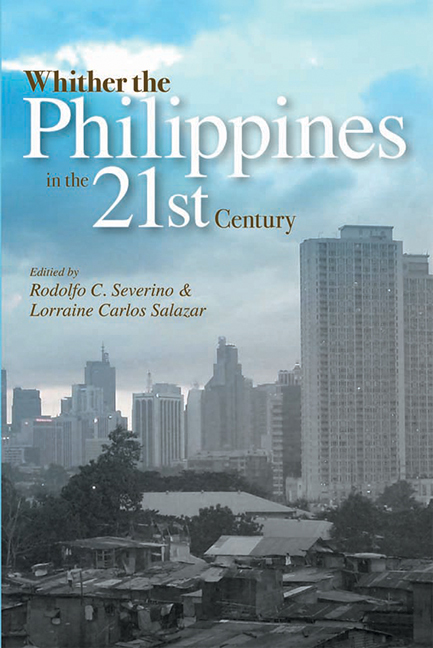Book contents
- Frontmatter
- Contents
- List of Illustrations
- Foreword
- Acknowledgements
- The Contributors
- List of Abbreviations
- Map of Southeast Asia
- 1 The Philippines in Southeast Asia
- 2 From Regime Crisis to System Change
- 3 Proposed Constitutional Reforms for Good Governance and Nation Building
- 4 The Military in Philippine Politics
- 5 Religion and Politics
- 6 The Philippine Press
- 7 Macroeconomic Issues and Challenges
- 8 Investment Climate and Business Opportunities
- 9 Why Does Poverty Persist in the Philippines?
- 10 Diaspora, Remittances, and Poverty
- 11 The Philippine Development Record
- 12 Sancho Panza in Buliok Complex
- 13 The Insurgency That Would Not Go Away
- 14 Whither the Philippines in the 21st Century?
- Index
1 - The Philippines in Southeast Asia
Published online by Cambridge University Press: 21 October 2015
- Frontmatter
- Contents
- List of Illustrations
- Foreword
- Acknowledgements
- The Contributors
- List of Abbreviations
- Map of Southeast Asia
- 1 The Philippines in Southeast Asia
- 2 From Regime Crisis to System Change
- 3 Proposed Constitutional Reforms for Good Governance and Nation Building
- 4 The Military in Philippine Politics
- 5 Religion and Politics
- 6 The Philippine Press
- 7 Macroeconomic Issues and Challenges
- 8 Investment Climate and Business Opportunities
- 9 Why Does Poverty Persist in the Philippines?
- 10 Diaspora, Remittances, and Poverty
- 11 The Philippine Development Record
- 12 Sancho Panza in Buliok Complex
- 13 The Insurgency That Would Not Go Away
- 14 Whither the Philippines in the 21st Century?
- Index
Summary
INTRODUCTION
The twentieth anniversary of the Philippines' People Power was marred by the sudden declaration of a state of national emergency, a day prior to its scheduled commemoration on 25 February 2006. Reports from Malacañang Palace had cited alleged coup plots by renegade military officers and an apparent “tactical alliance” between right-wing and communist forces to overthrow the government of President Gloria Macapagal-Arroyo.
Notwithstanding security concerns, of significance in the latest coup attempt were the different ways it was viewed depending on one's vantage point. For those who are no strangers to the vicissitudes of Philippine politics, particularly for those who were outside the capital Metro Manila, it was business as usual. To the hardened cynic, it appeared as if the latest coup attempt was just one of the occasional blips that punctuated the country's political landscape, given that in the post-martial law era, the Philippines had already had nine coup attempts, including the seven mounted against the Aquino administration (1986–92). The country's recent political landscape has been starkly defined by the history of two other “people power” movements: EDSA (Epifanio de los Santos Avenue) 2 in 2001, which brought President Arroyo to power, and the lesser known EDSA 3 (also in 2001) which challenged Arroyo's legitimacy. Dramatic twists and turns followed the 2004 elections, which saw the current Arroyo administration besieged by incessant demands for her resignation due to allegations of cheatings in the past elections. These were seen in the street demonstrations that almost culminated in another Edsa-like “revolution” in July 2005 and were heard in the cacophony of discourses from a rambunctious Congress mired in political infighting. One may also add to this vista the decades-long problem of communist insurgency and the intractable issue of separatism in the Philippines' Muslim South.
From the outside looking in, the current state of affairs in the Philippines reflects a perplexing paradox in Asia's first democracy.
- Type
- Chapter
- Information
- Whither the Philippines in the 21st Century? , pp. 1 - 17Publisher: ISEAS–Yusof Ishak InstitutePrint publication year: 2007



